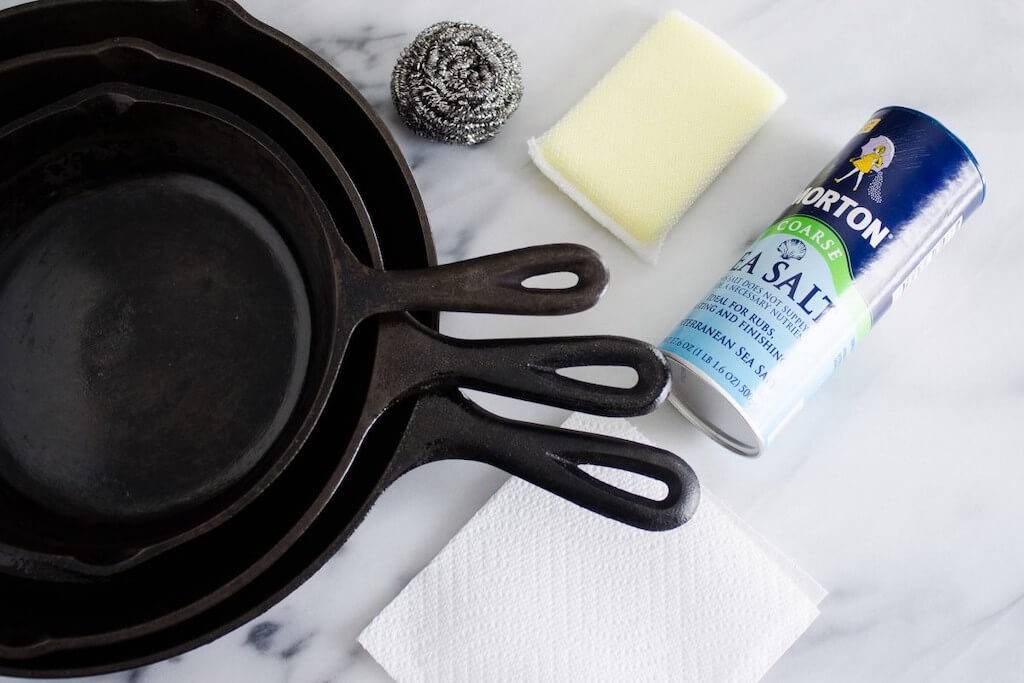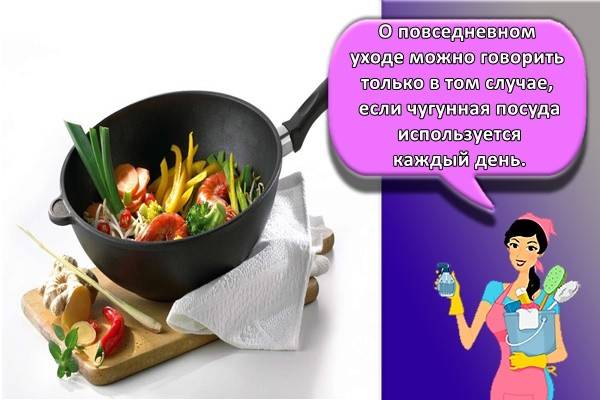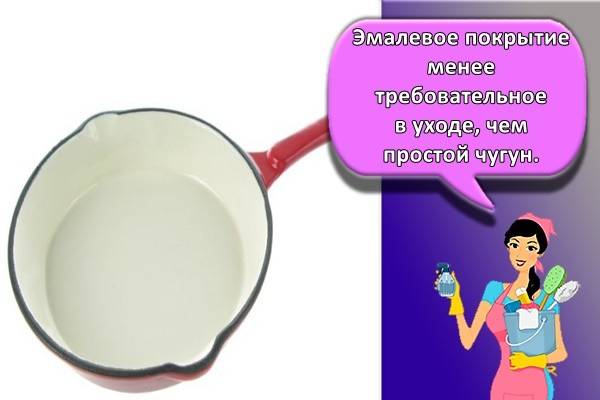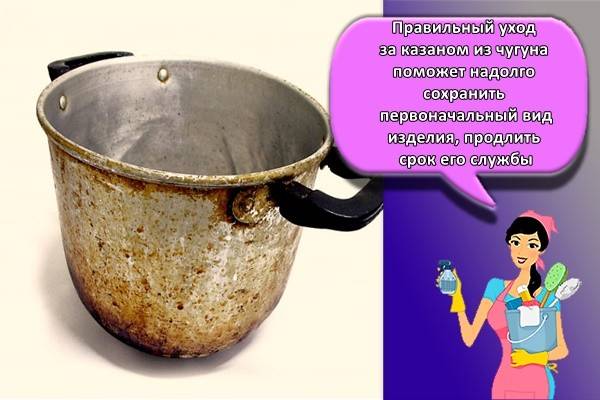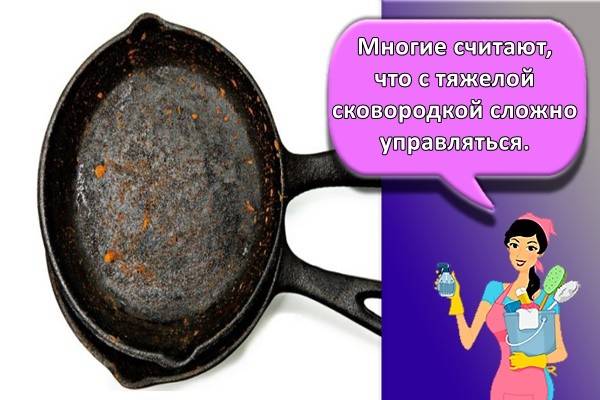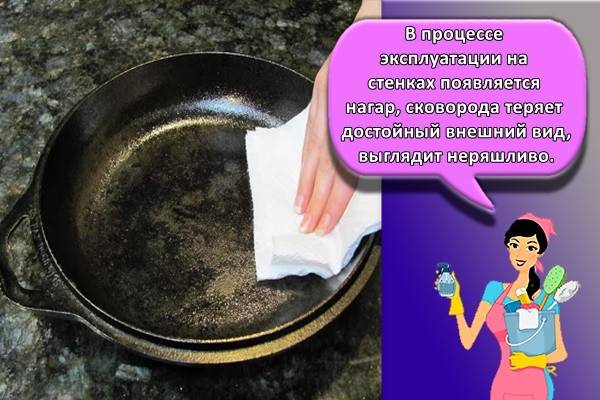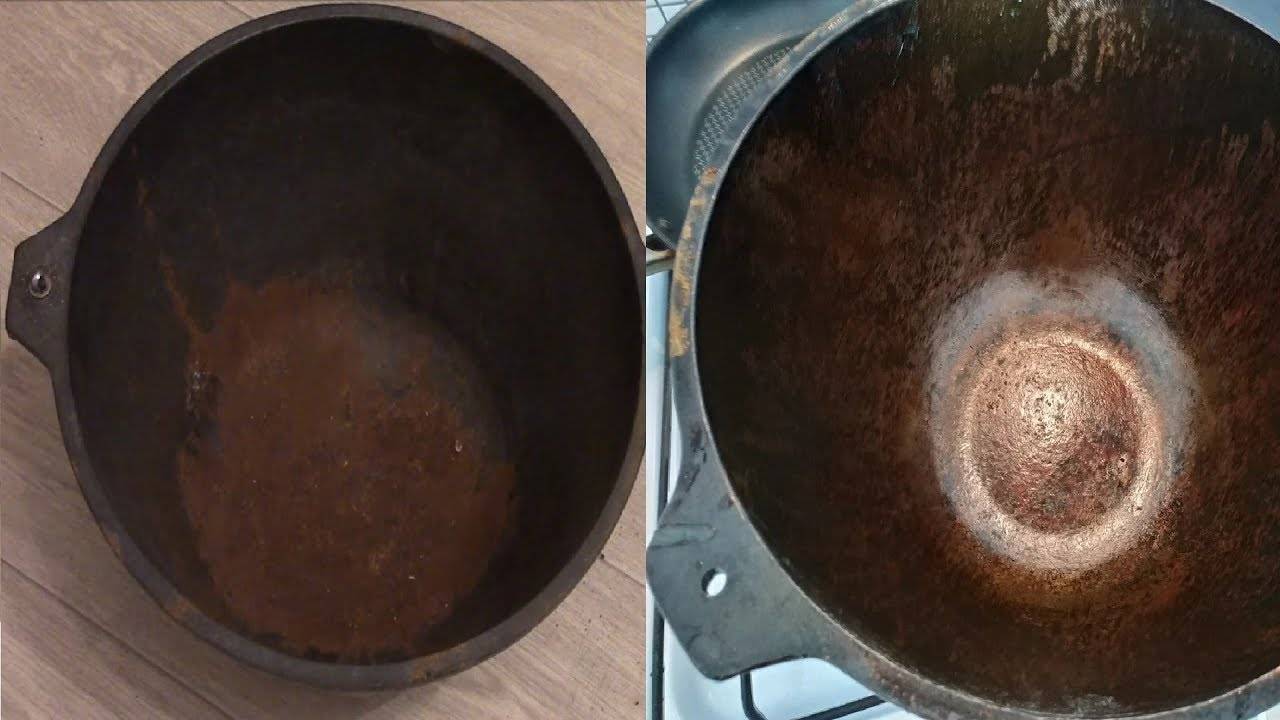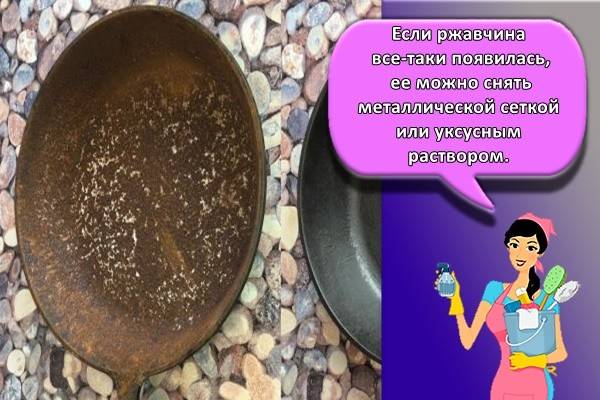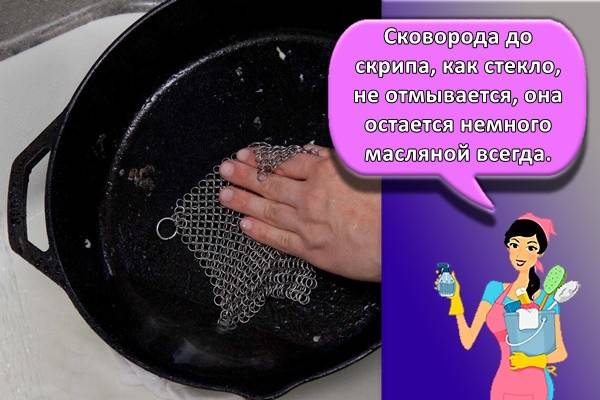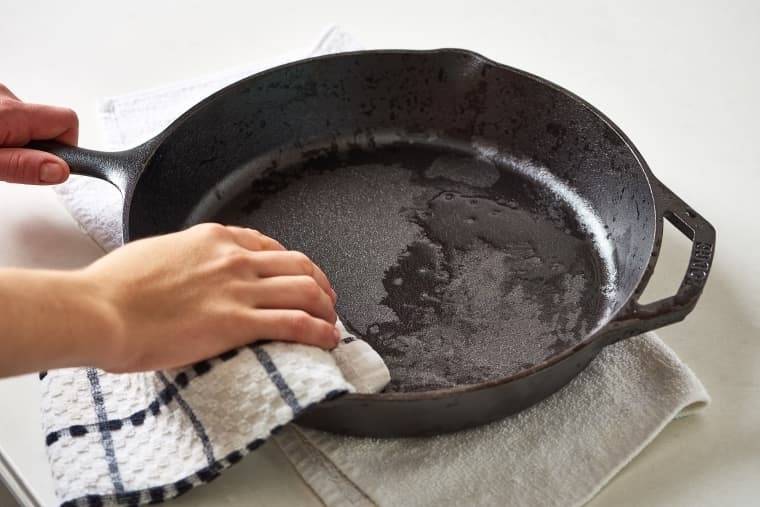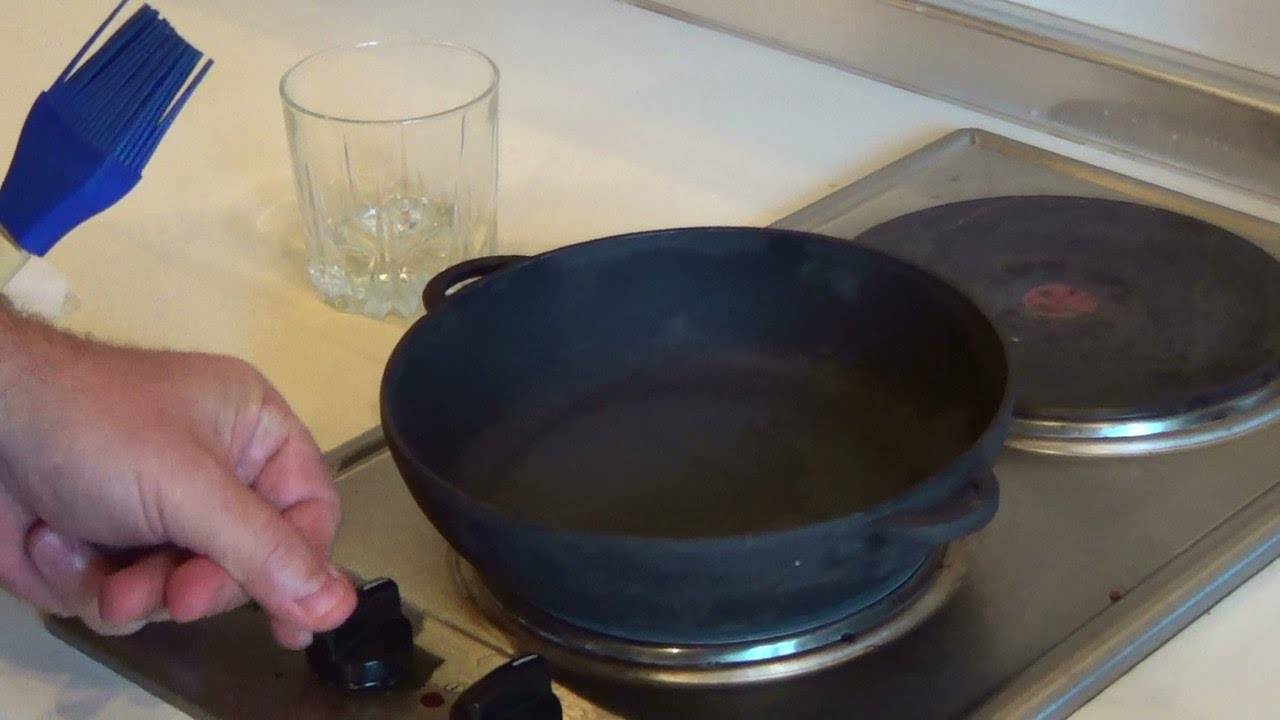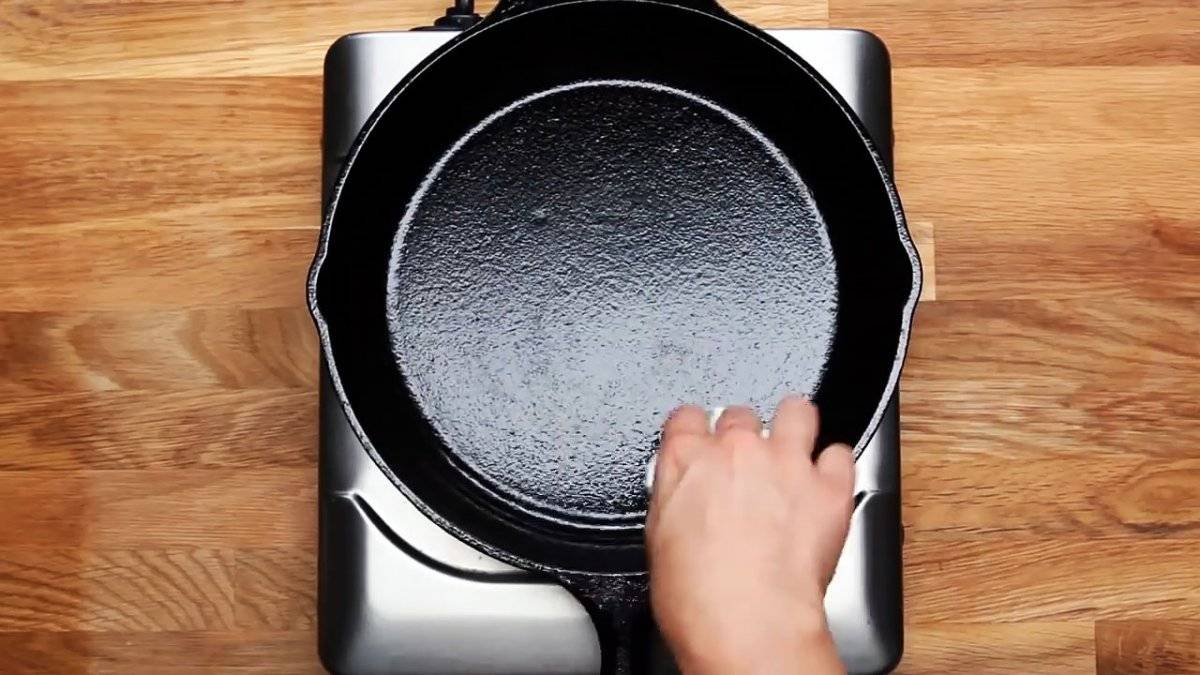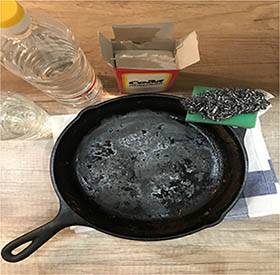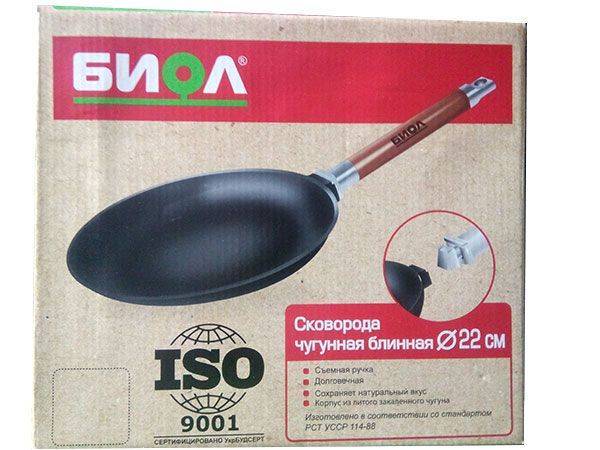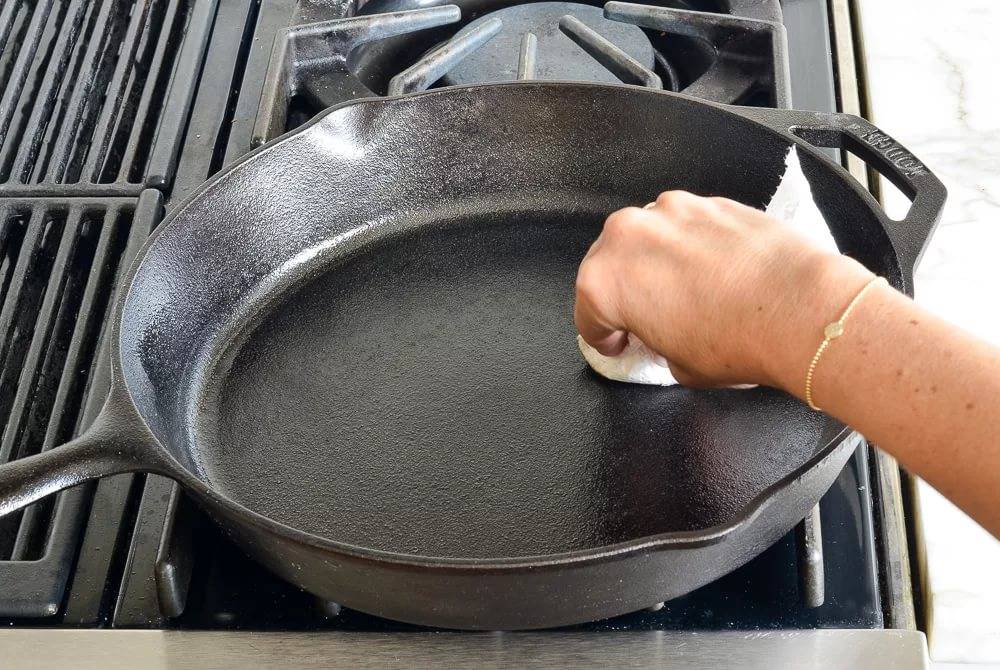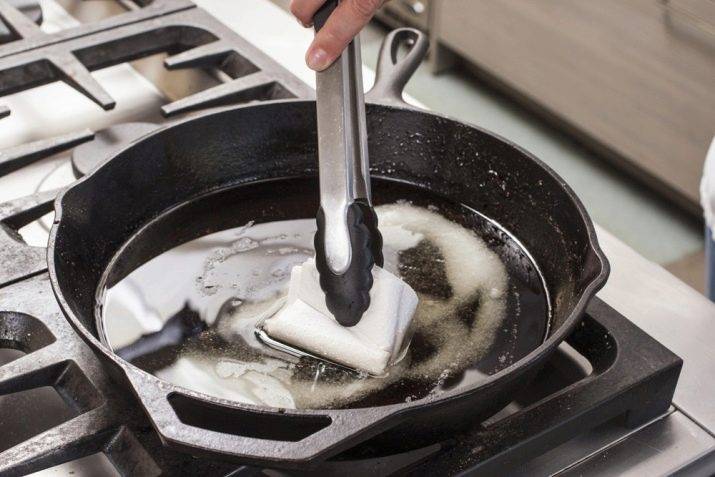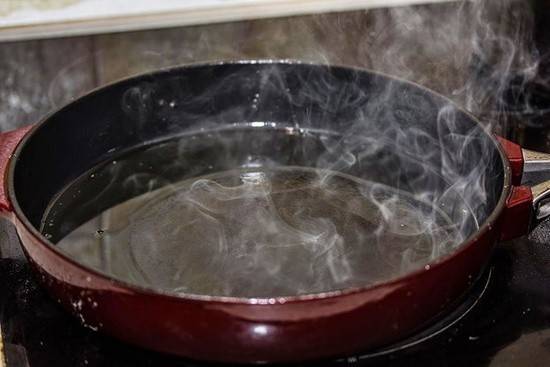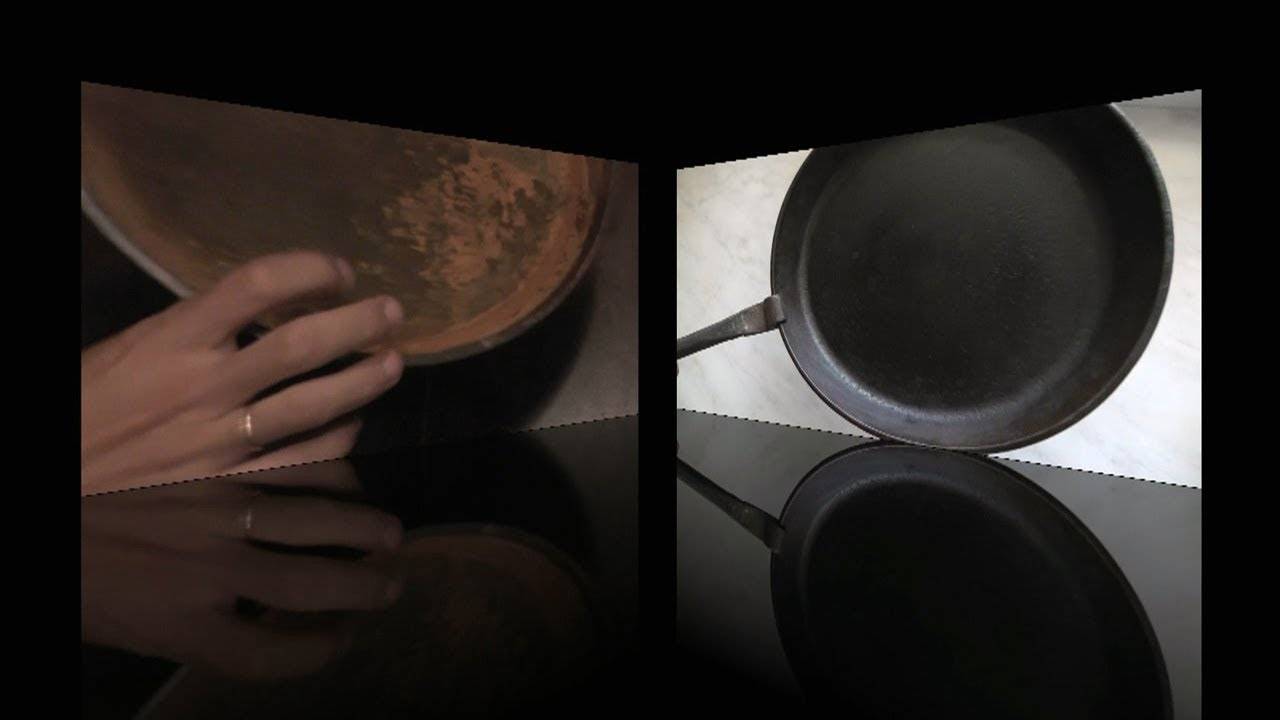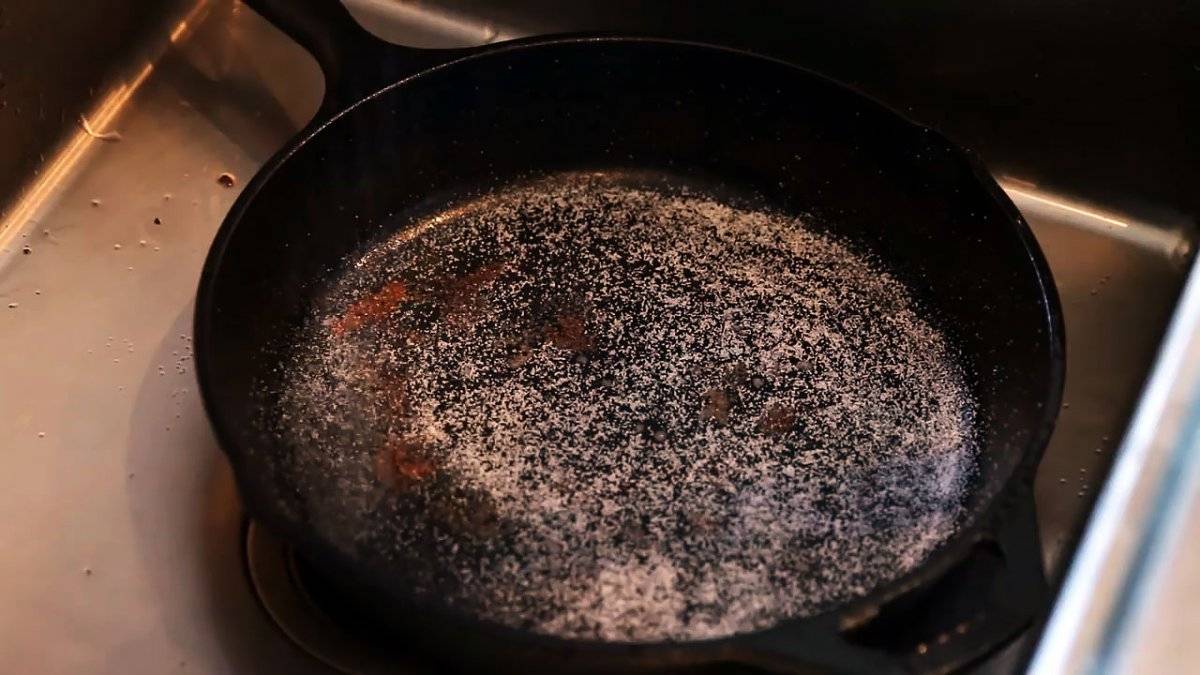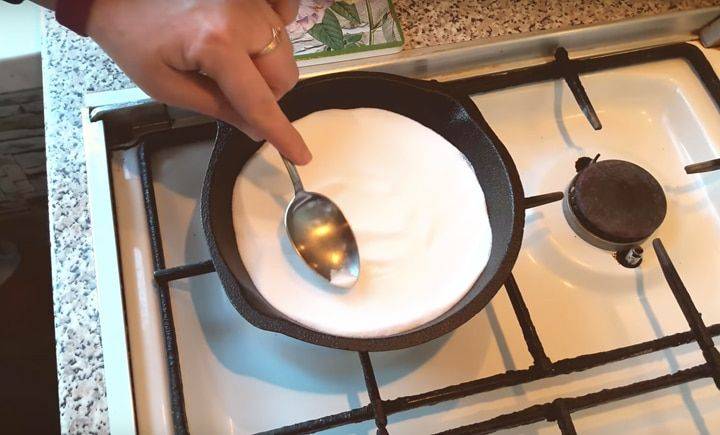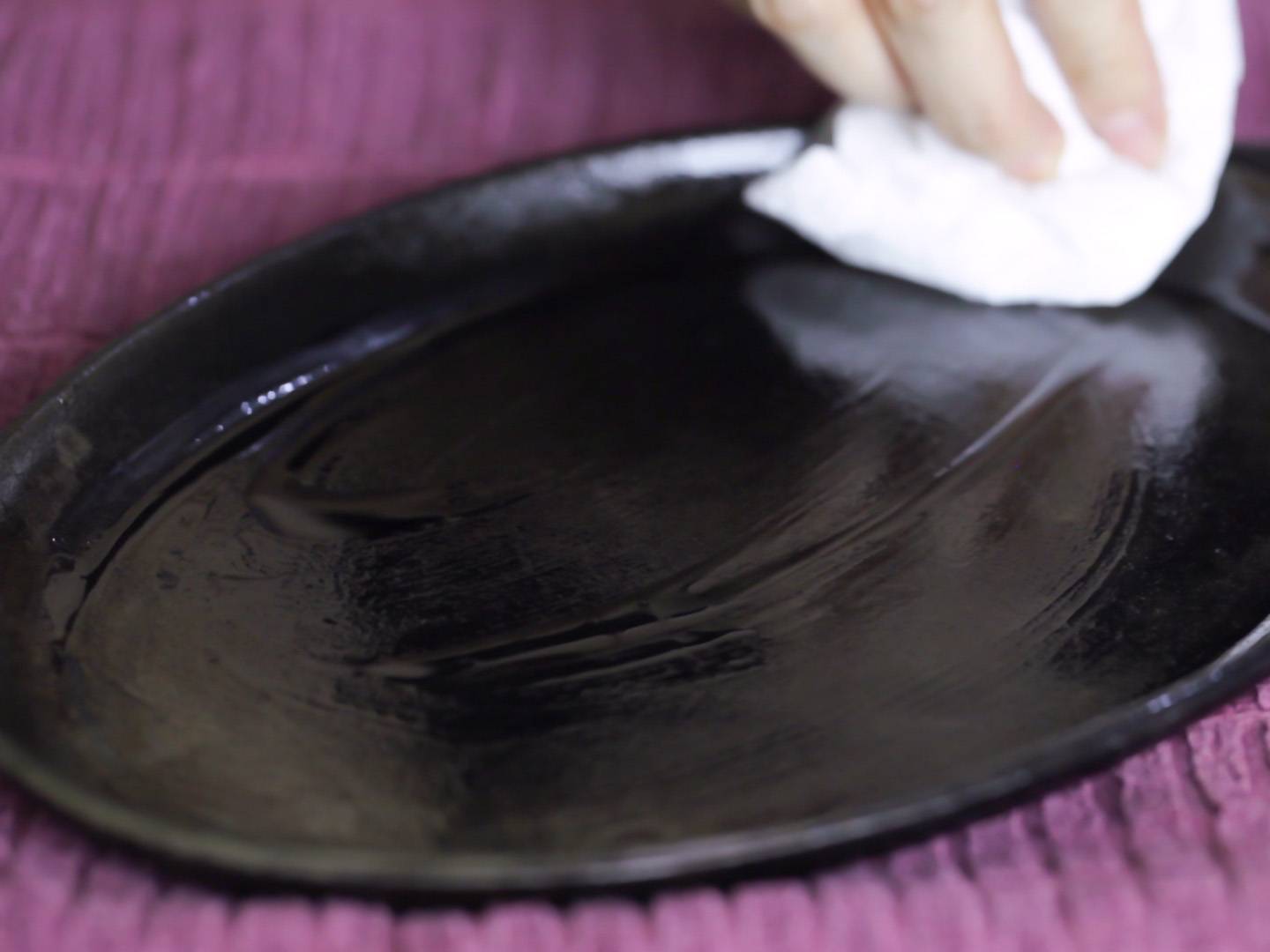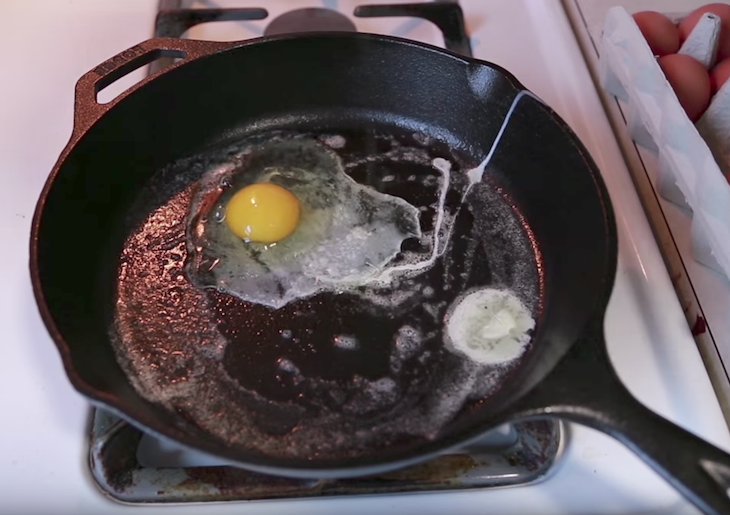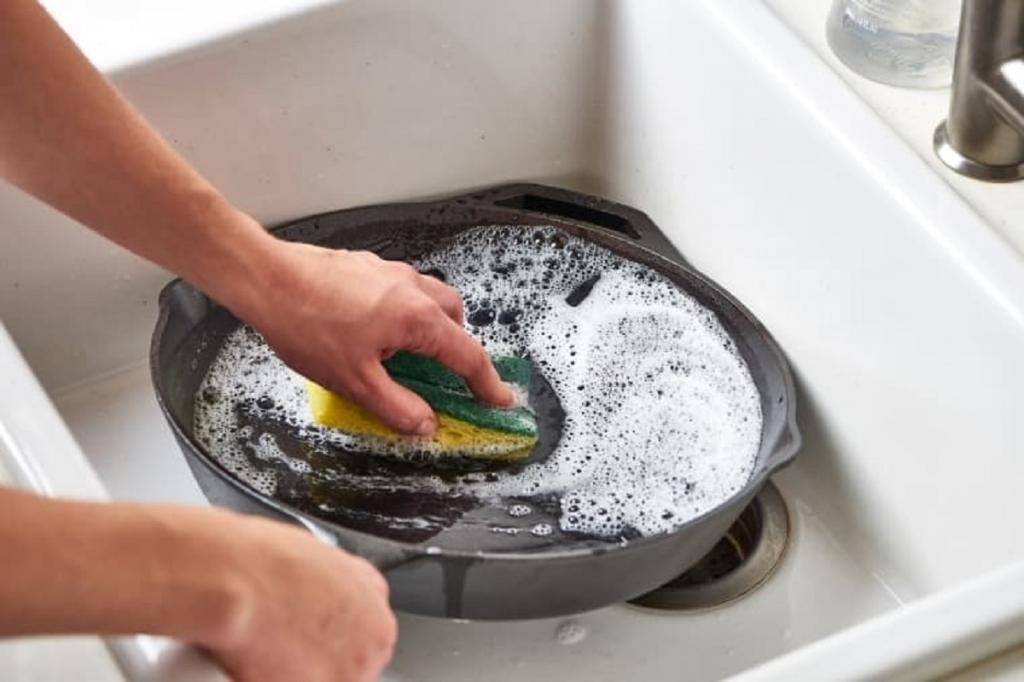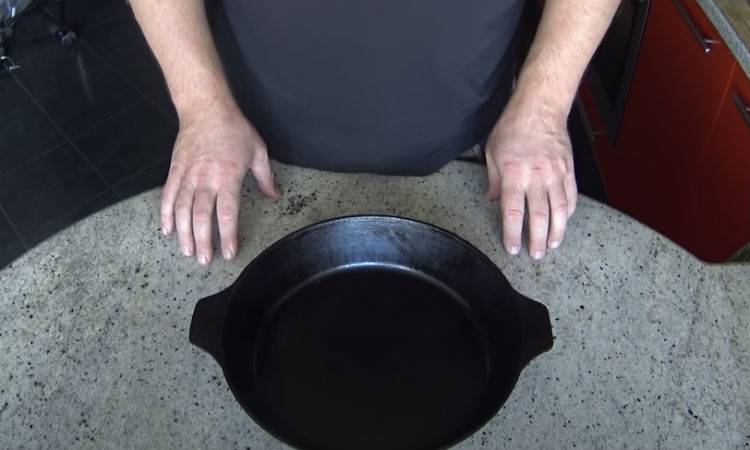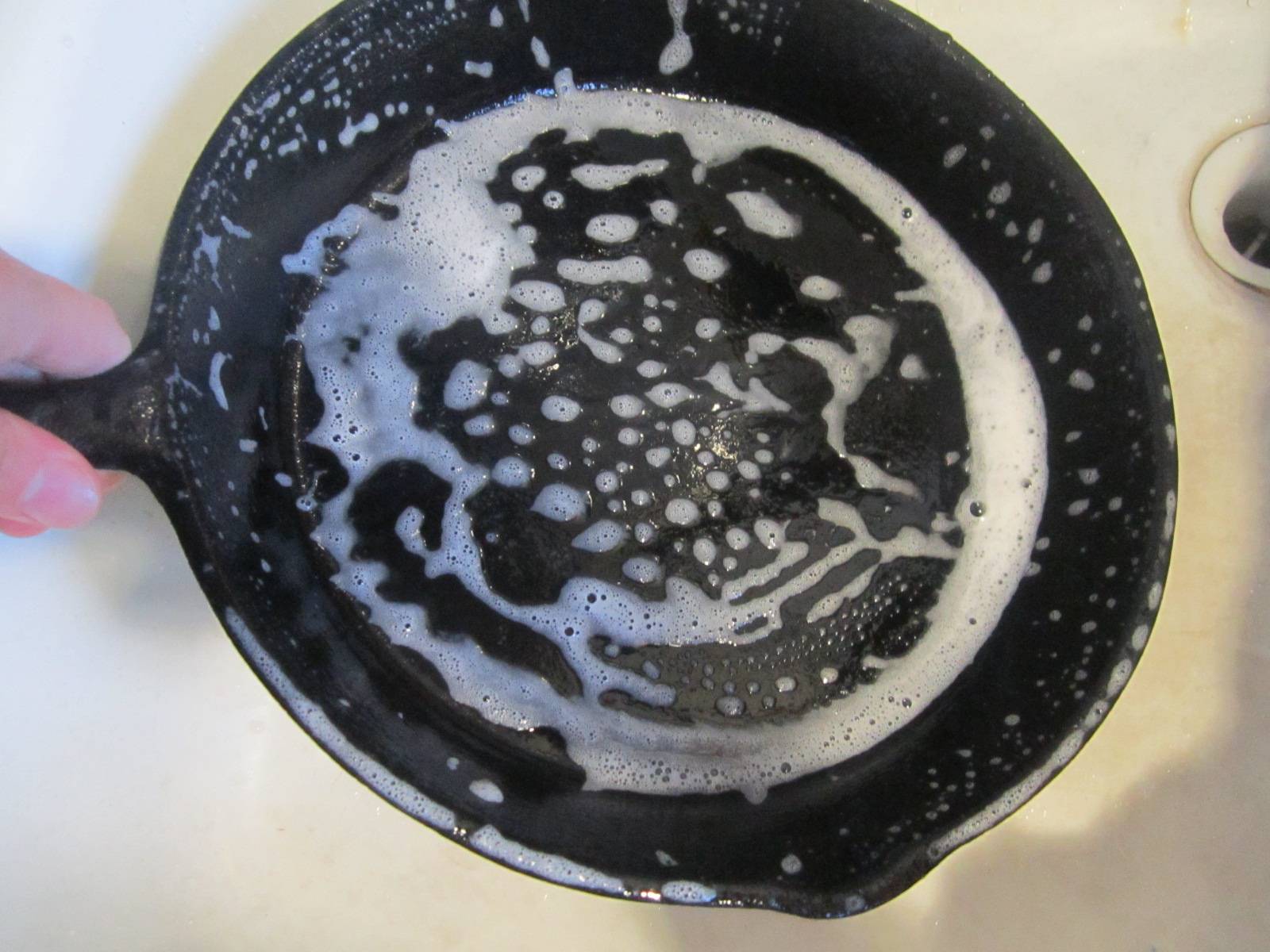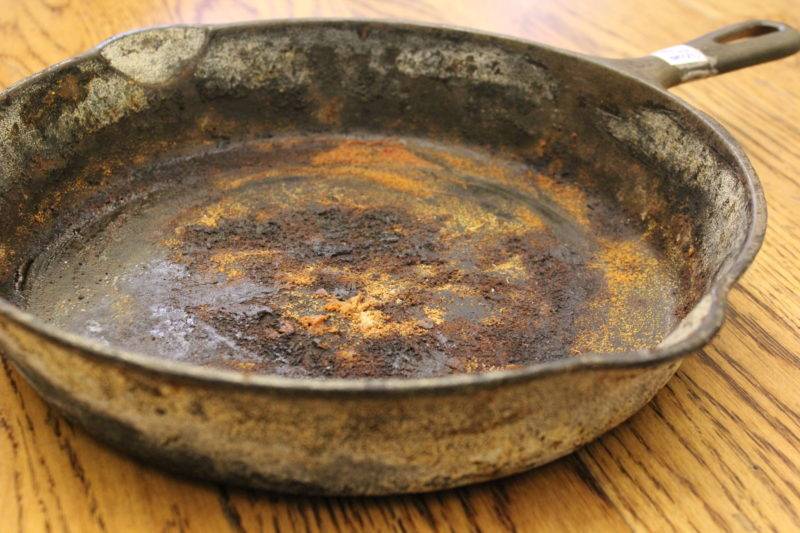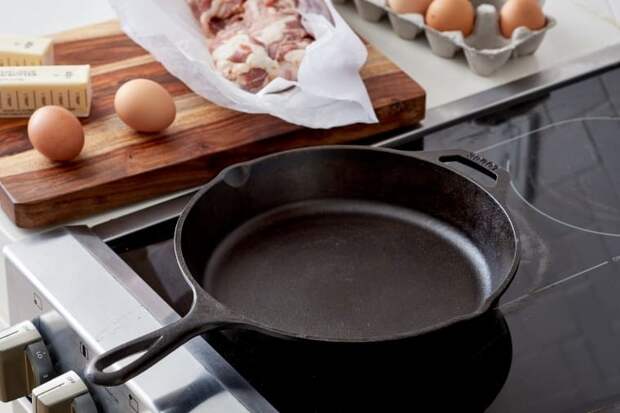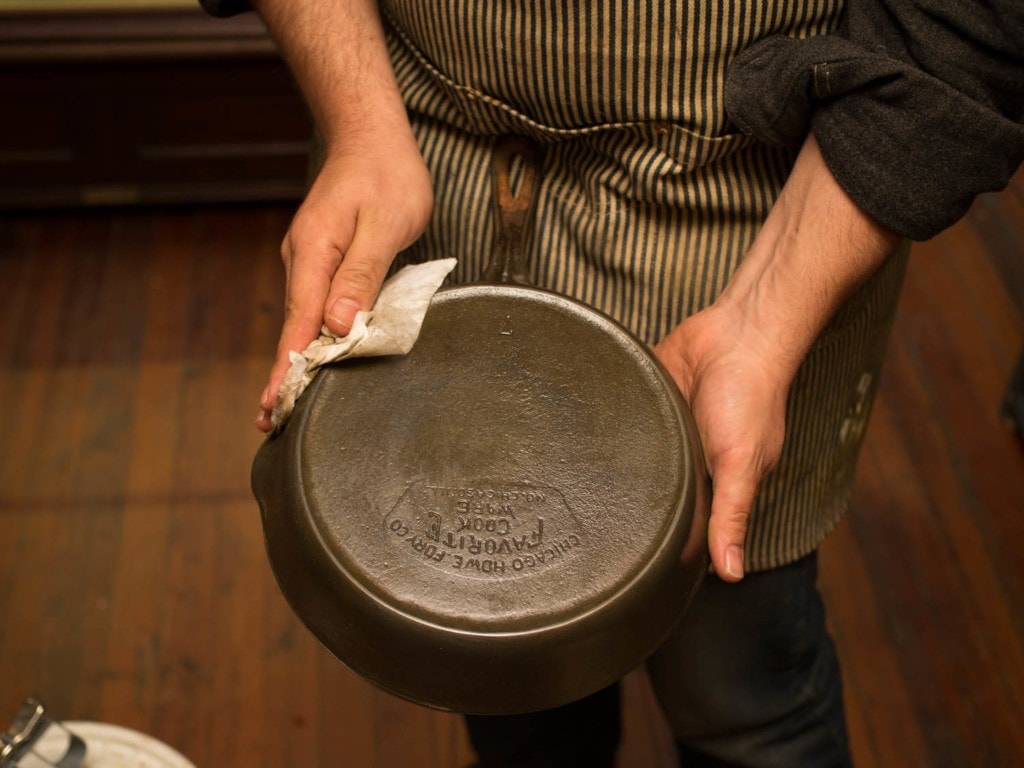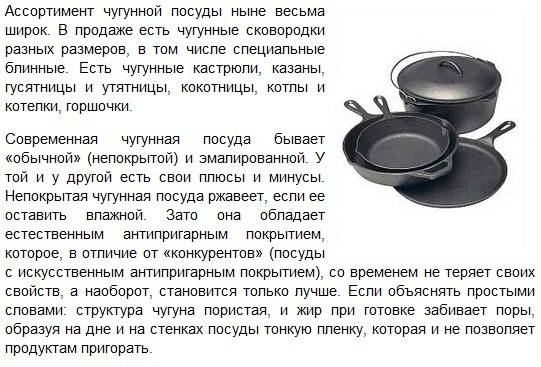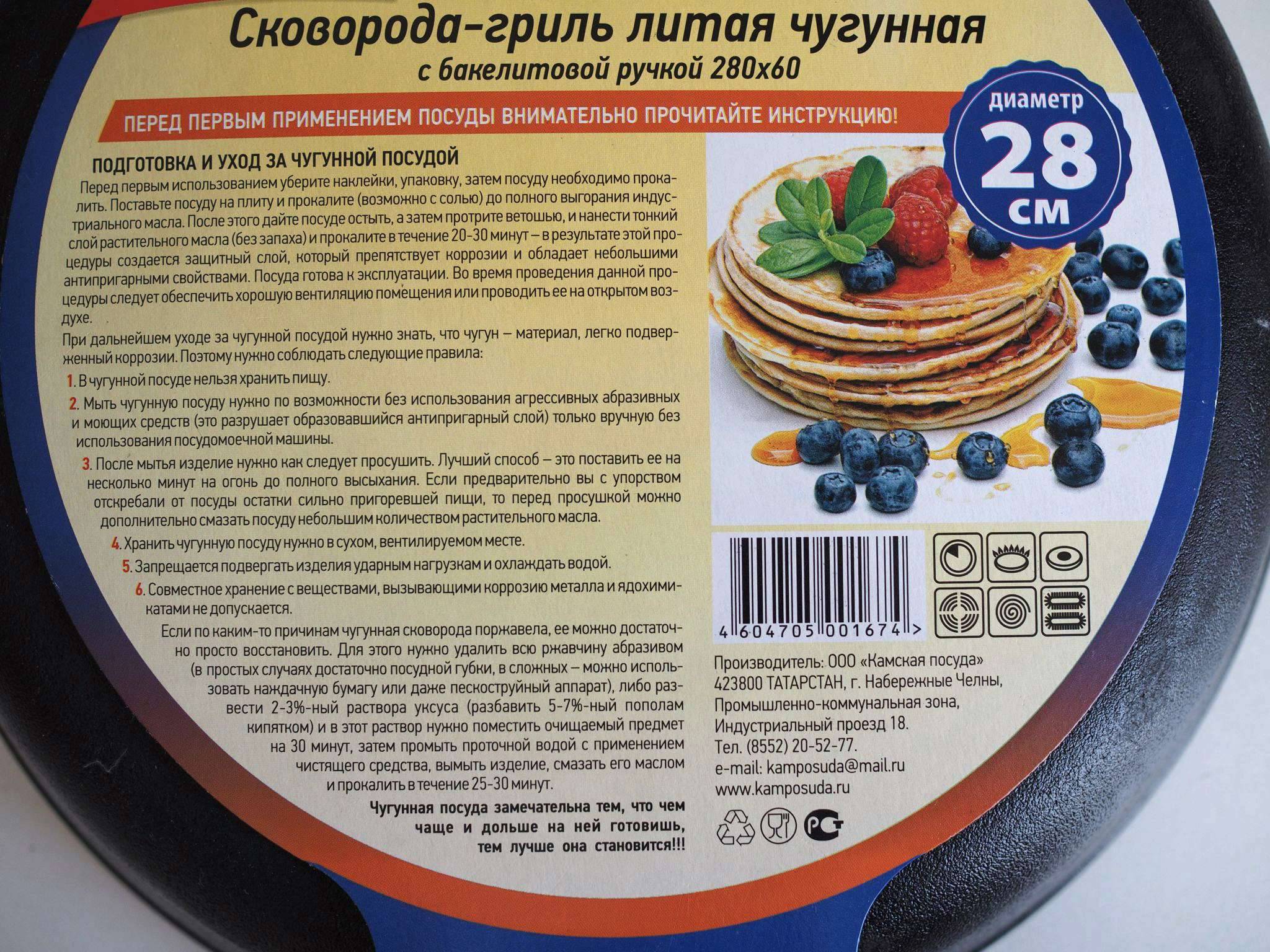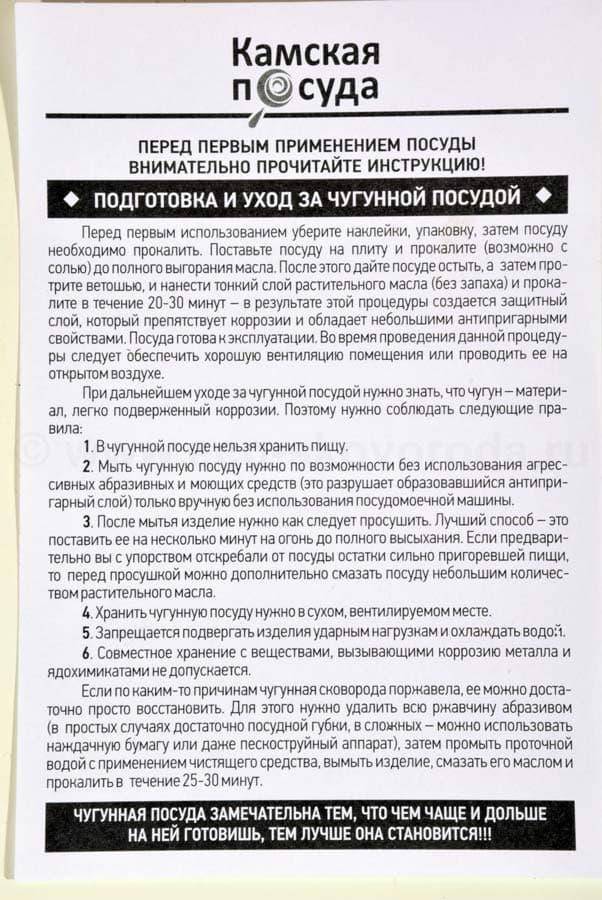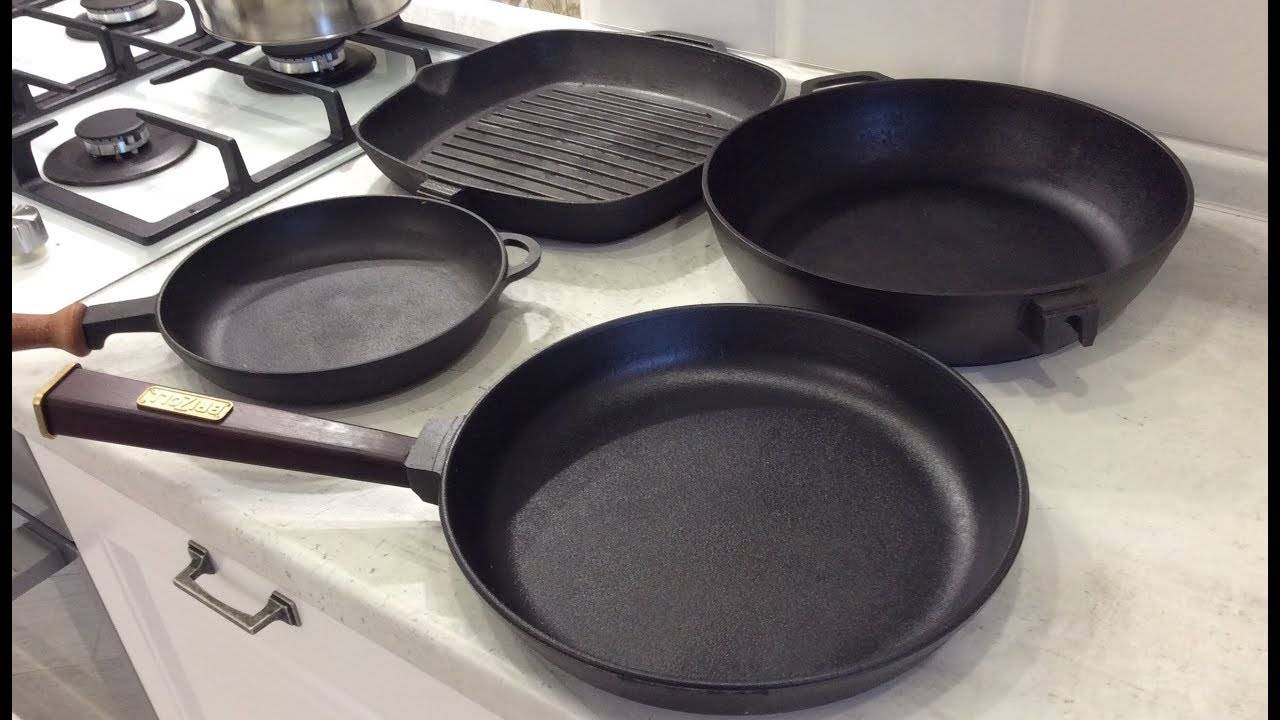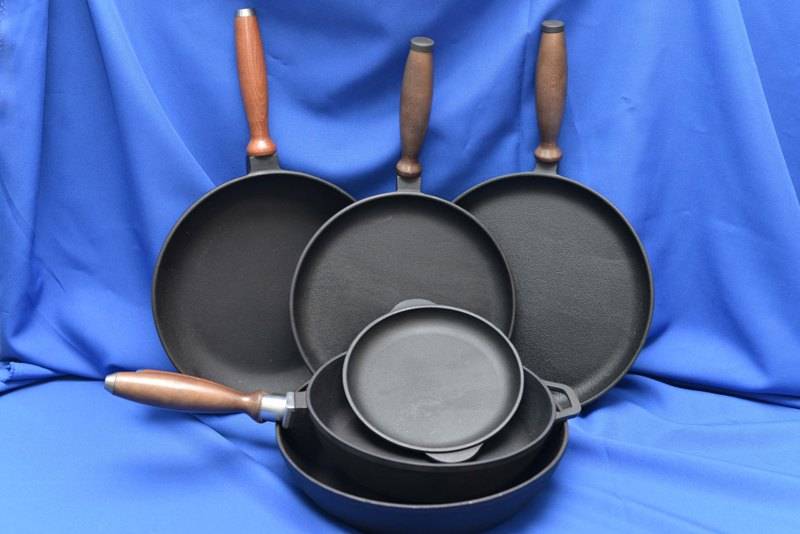What is it for
- First of all, this procedure is necessary for the safe preparation of food. The fact is that at manufacturing plants, in the production of cast-iron dishes, they are often lubricated with machine oil, which cannot be eaten. Primary treatment before use helps to destroy this layer.
- Cast iron itself is a porous material. If the surface is not treated, food particles will get into the pores, over time, the process of decomposition and decay will begin, which will lead to an unpleasant odor. In addition, in such a frying pan, in general, it is unlikely that it will be possible to cook a good dish, everything will certainly burn. When using a properly calcined frying pan, you can fry without oil, like expensive Teflon. And washing it is much easier and more pleasant.
- Among other things, annealing serves as an excellent test of the quality of the cookware. If during the procedure the product is cracked, the bottom is deformed, or the pan itself has changed its shape, feel free to ask the product back to the store. All this is a consequence of poor quality raw materials.
Preventive measures against rust and care recommendations
Prevention will always be better for your pan than tedious cleaning and a long process of rebuilding the non-stick protective layer.
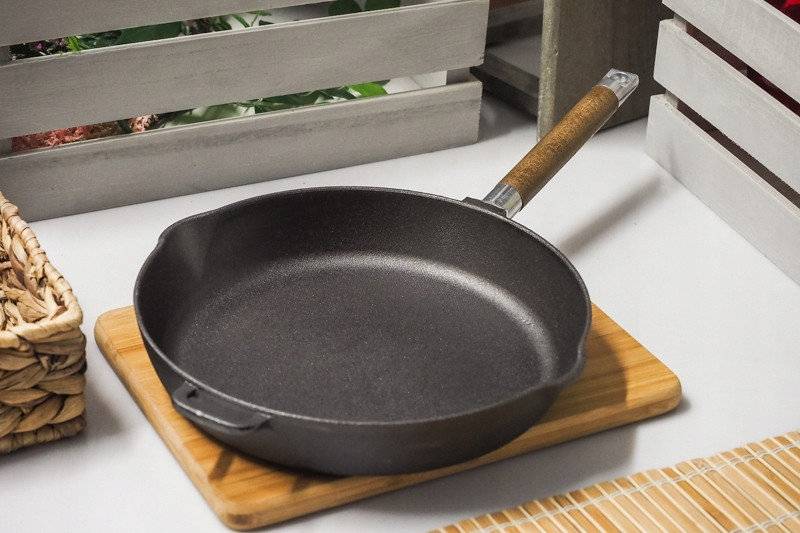
Regularly, it is necessary to carry out measures to restore the non-stick coating of the cast iron pan.
Necessary measures to protect cast iron products from rust:
- Regular use of the frying pan prevents rust stains, the oil in which we cook constantly replenishes the natural protective layer.
- After cooking, wash and dry the pan immediately.
- Store the product, especially if it is not used for a long time, in a dry place, after having lubricated it with oil.
- When washing, do not use metal brushes or products that contain abrasives, baking soda is perfect for daily cleaning, it does not violate the protective layer of the product.
- Heat the product periodically in the oven with oil, then you will not be afraid of rust.
- Do not store ready-made meals in a frying pan, an oxidative process occurs when in contact with foods that violate the integrity of the protective layer and the taste of food.

The dishes should be washed after every cooking.
With regular prevention and proper use of the frying pan, it will serve you for a long time and will be inherited by your grandchildren. And they will appreciate the quality and durability of cast iron products in their kitchen.

There are cast-iron dishes in every home, so that it lasts a long time, it is necessary to carry out timely prevention of the appearance of dark spots.
How to remove corrosion with household products
The tools that are in any home will help get rid of rust in the pan. But it is worth remembering that the effect is long-term, it is necessary to approach cleaning comprehensively, then you will forget about removing rust stains for a long time.

If the cast iron is not properly maintained, it will become unusable due to the appearance of rust.
Soda. Used as a cleaning paste. Sprinkle 2-3 spoons on the surface, add a little warm water and rub the problem areas with a sponge - this will remove small signs of rust.

Removing carbon deposits with baking soda will restore the surface of the pan if the rust has not penetrated into the deep layers.
Salt. It is used in complex cleaning. Pour 5-6 spoons into a frying pan and heat on the stove for 10-15 minutes, let cool slightly and add water to still warm salt. It will be enough to slightly clean the surface and wash.

Table salt can help get rid of rust in a cast iron skillet.
Vinegar solution. It is necessary to dilute 2-3 tablespoons of vinegar in water and pour the composition into a frying pan.Let stand for several hours, then rinse and dry.

When acid comes into contact with dark spots, it breaks them down and turns them into a powder.
Coca Cola. The soda we all love will do a great job of cleaning the pan of rust. Pour the drink into a large saucepan (3-5 bottles) and bring to a boil. Dip a frying pan into a boiling Coca-Cola and boil for 30-40 minutes, let the drink cool without taking out the pan. Next, you just need to wash the product and dry it.
They contain phosphoric acid, which is used in many plumbing products and cleaning products.
Pemolux. It will clear the manifestations of rust, just rub the problem areas a little with a cleaning agent and a little water. But it is desirable to use it in combination with rubbing with oil and roasting in the oven.

For this method, they take a powder with abrasive particles and a hard metal sponge and forcefully clean the surface of the dishes.
Oven products. They will clean the rust well and quickly, but the alkali in the composition will remove the protective layer from the product and it will have to be restored.

Use hand protection when applying.
Special chemicals. If simple folk remedies no longer help, and the rust has gone deep into the metal, then you cannot do without these means. In the store you will find a wide variety of such products that contain strong acid or chlorine in their composition.
When using them, you must follow the precautions: wear rubber gloves, apply the product with a brush, which is included in the kit, and try not to inhale the vapors

After cleaning, rinse the pan with plenty of water and dishwashing detergent.
Fish oil or flaxseed oil. They are used to restore the protective layer of the product in combination with annealing in the oven. Rub the surface with a thick layer of fat or oil and place in the oven at medium temperature for an hour. After cooling, remove excess with a soft cloth. When using fish oil, there may be a fishy odor, it is necessary to rinse the product with detergent to remove the strong odor.

Fish oil easily removes rust from a cast iron pan.
Calcining option 2
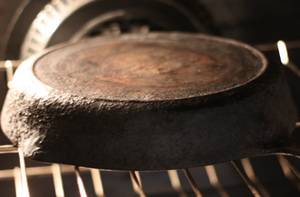 First you need to wash the product with laundry soap, rinse thoroughly and dry. We put it on a well-heated induction or gas stove and warm it up well. Pour the salt into a 2 cm layer and stir constantly until the salt turns dark brown. This product is no longer needed, it cannot be used for food, since it absorbed the machine oil with which the pan was greased.
First you need to wash the product with laundry soap, rinse thoroughly and dry. We put it on a well-heated induction or gas stove and warm it up well. Pour the salt into a 2 cm layer and stir constantly until the salt turns dark brown. This product is no longer needed, it cannot be used for food, since it absorbed the machine oil with which the pan was greased.
At the second stage, we pour a lot of oil into the container, if possible, right to the brim. We put on low heat and wait 20 minutes from boiling. The product will automatically absorb the required amount of oil. Care must be taken so that oil does not splash out during boiling, otherwise a fire may occur, especially if a gas stove is used. After cooling, drain the oil and wipe the product dry with a paper towel. To avoid strong unpleasant odors, it is best to use refined oil.
Methods for annealing cookware made of other materials
Calcining is needed not only for cast iron products, but also for pans made of other materials. Cookware made of stainless steel is calcined in the same way as cast iron. You can choose the method of calcining with salt, or use fat or vegetable oil. In both cases, the desired result will be achieved.
Methods of calcination are different for dishes made of aluminum. How to ignite an aluminum frying pan and do it right? You can use one of these methods:
- Wash and dry the pan.Pour vegetable oil into the dish; it should be enough to completely cover the bottom. Add 1 tablespoon of table salt and place the container over medium heat. It will need to be heated until the oil gets very hot and a specific smell appears. This usually takes 15–20 minutes.
- Before calcining, rinse the dishes well and pat dry with a tea towel. Rub the surface with vegetable oil, not only from the inside, but also from the outside. Preheat the oven to 180 degrees and place the pan in there for 1 hour. Please note that the container should be placed upside down. After the dishes are calcined, the oven must be turned off, but the pan cannot be taken out immediately. Wait until it has completely cooled down, and only then get it out.
- Pour table salt on the bottom of the previously washed dishes so that the bottom is completely covered. Heat the skillet over low heat until the salt darkens, then let the container cool and rinse with water and a mild detergent.
Calcination forms a protective layer on the surface that will prevent food from burning and protect the surface from burnt fat stains.
Pour vegetable oil into the container so that it completely covers the bottom, and ignite over moderate heat for at least 15 minutes. Allow the pan to cool before pouring out the oil and then gently rinse with warm water.
The proposed method of calcination will extend the service life and strengthen the non-stick properties of ceramic coated cookware. These tips will allow you to keep the frying container in "working" condition for a long time and avoid unnecessary costs for purchasing new cookware.
Useful Tips
What to do if the cast iron pan is uncoated. There are devices with:
- induction bottom;
- enamel processing;
- non-stick coating.
Kitchen appliances are often adapted to fit certain types of stoves. Cast iron pans for a glass ceramic hob must be made of magnetic material. Glass-ceramic dishes must have a flat bottom and this bottom must not have roughness or notches. Otherwise, energy costs increase, and the surface of the stove is severely damaged.
Another option - cast iron pans and induction cookers - are well compatible, since cast iron has good ferromagnetic properties. For these stoves, special saucepans with an induction bottom are being developed. Cooking on an induction hob is completely environmentally friendly and safe. The principle of operation of an induction cooker is to heat the cookware by induced eddy currents generated by a high-frequency magnetic field with a frequency of 20-100 kHz. This frequency is not perceived by the human ear and therefore does not interfere with everyday comfort. Considering the fact that cast iron is composed of iron and carbon, it is an excellent choice for an induction furnace.
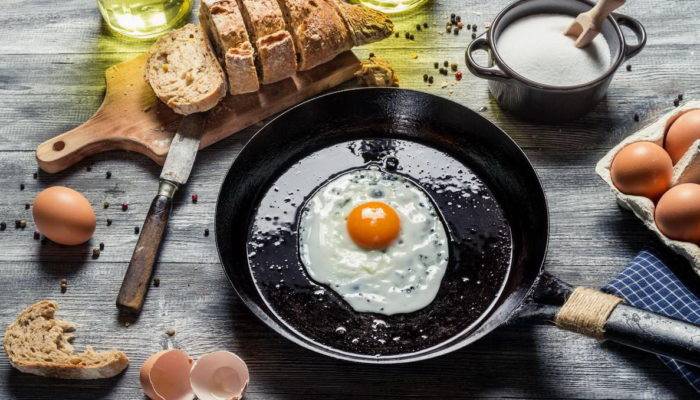
Now induction cookers have appeared, which themselves determine the nature of the material installed on them, and, if it is not a ferromagnet, the cooker does not turn on. The bottom of the cookware should be even, as the convex one can emit a hum, working like a diaphragm in an electromagnetic speaker.
The modern market offers a very wide selection of cast iron cooking appliances. To understand which firms are better, you need to determine the priorities:
- price;
- suitability for your stove;
- aesthetic appearance;
- the severity of the product;
- ergonomics, ease of use;
- wall thickness, purpose of cooking;
- reputation of the manufacturer, customer reviews.
When buying a cast iron stewpan, one must assume such an option that even grandchildren can use this product, because these kitchen utensils are very strong and durable.
How to clean an uncoated cast iron pan
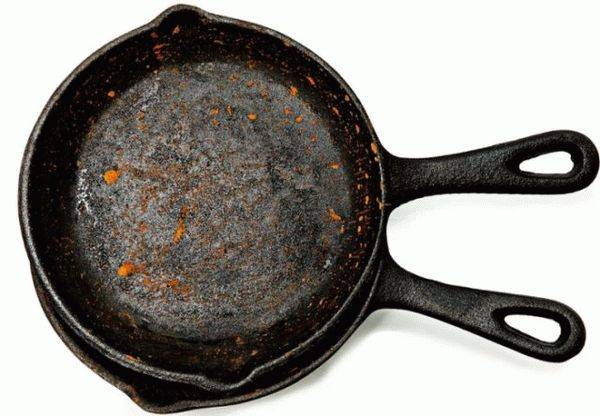
General rules of care
The main rule of washing dishes made of cast iron is not to harm.The most harmless consequence of improper care is the violation of the oil coating, which prevents sticking and burning of products. The most serious is the formation of rust.
Precautionary measures:
- Do not scratch the surface by scraping off burnt food - this will damage the natural oil non-stick layer and cause micro-scratches. Later, bacteria can live in these lesions and rust can form.
- If possible, do not use dishwashing detergents that remove grease. The reason is the same - the natural coating will dissolve, the food will begin to stick.
- Do not boil water for a long time to get rid of contamination, otherwise you will have to ignite the pan with oil.
- Do not soak for a long time with water and soapy solutions - cast iron can rust.
- Do not fill hot dishes with cold water. From a sharp temperature drop, the product may even crack.
- Do not use a dishwasher unless the manufacturer has indicated what can be washed this way.
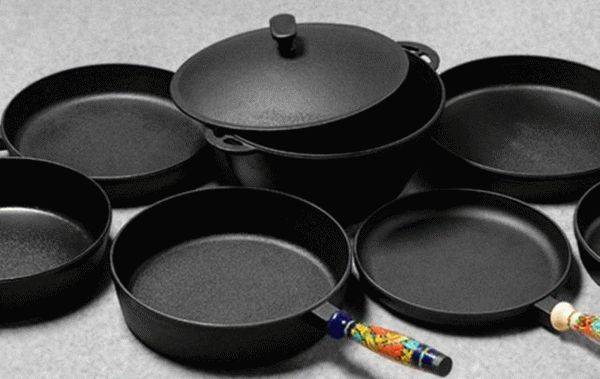
How to properly wash an uncoated cast iron pan:
- Let cool, do not rush. Otherwise, there is a risk of burns.
- Wipe the inside of the bottom and sides with a paper towel or tissue.
- Wash with warm water and mild detergent. There are special ones for cast iron, it is worth buying these if there are a lot of cast iron dishes in the house.
- Wipe dry immediately with a soft microfiber cloth - a very practical material, absorbs moisture quickly, does not leave streaks, and is easy to clean.
- If you rarely use a frying pan, apply a thin layer of oil, heat it up (so there is no unpleasant smell) and wipe again.
- Store in a dry, ventilated place. Use spacers if you have to stack pans on top of each other.
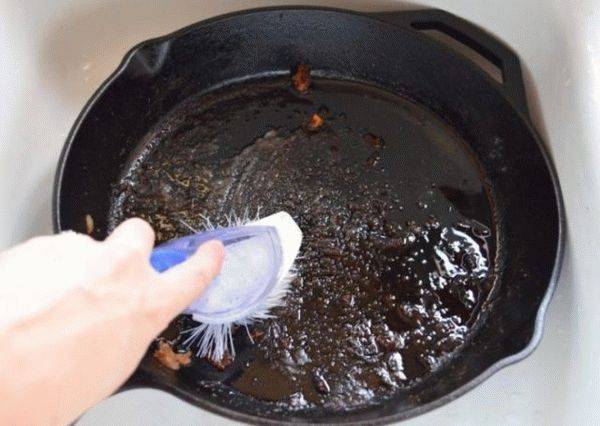
The easiest way to take care of cast iron pancake pans is that you don't have to wash them at all, but only wipe them if you only cook pancakes.
When the cast-iron pan is heavily soiled and the food is burnt, you will not have to wash it, but do a general cleaning. All recommendations described above are given in order to preserve the protective coating. But cast iron itself is not afraid of scratches.
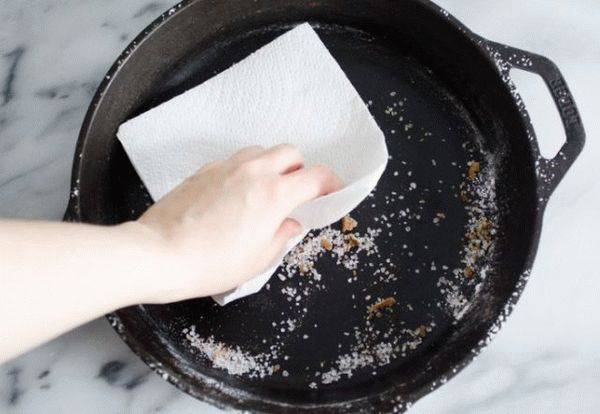
To get rid of the remains of stuck meat or other food, you can boil the pan with detergent, clean it with a washcloth or brush. Ordinary salt works well - cleans delicately, at the same time removes bacteria from pores and cracks. But after such cleaning, be sure to carry out the same steps as immediately after purchase. Lubricate with oil and ignite.
Features of the care of the grill pan
About a third of housewives who bought a grill pan rarely cook on it, not knowing all the benefits. And many simply do not know how to properly wash a cast iron grill pan after frying.
All the rules listed above apply here. But there is a complication - oil and dirt accumulate between the ribs and on their side surfaces. If you can't wash with hot water, try using a salt paste to remove the dirt.
Pour some water on the bottom, add coarse table salt and spread the resulting paste with your hands, a brush or a sponge. Salt does not remove the grease film as aggressively as detergents, and the scrubbing properties help to get rid of the effects of frying in hard-to-reach areas. If it doesn't work the first time, repeat the procedure.
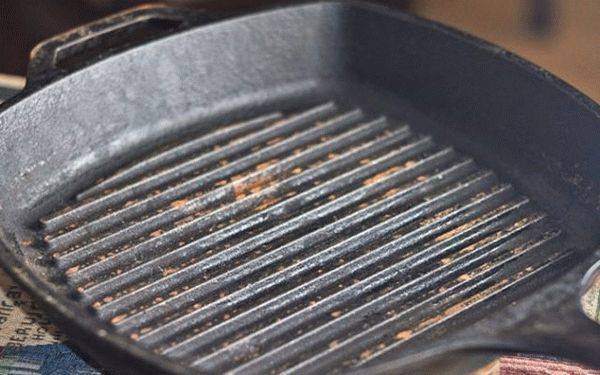
Difficult burnt areas will have to be brushed and removed by boiling. Especially if you have fried fish, as there is a risk that an unpleasant smell will remain. After fish, it is always advisable to wash the cast-iron pan with salt - it removes fish odors. Be sure to lubricate the surface with odorless oil after cleaning and warm it up well.
Mistake # 3. Improper cleaning of a cast iron pan
How to properly clean a cast iron pan:
- Immediately after cooking, rinse the pan with warm water, add a pinch of baking soda and wipe with a dishwashing sponge. Baking soda neutralizes all odors and has antibacterial properties.Rinse the pan with clean water and pat dry with a dishcloth.
- Thanks to the pre-treatment, there is no need to soak the pan.
- Lightly coat the skillet with vegetable oil to prevent it from drying out after use.
Mistake # 4. You never use dishwashing detergent
You think that caring for your cast iron skillet with dishwashing detergent is wrong. You are wrong! A small amount of dishwashing detergent will not harm her in any way. Although, if the care of the cast-iron frying pan is correct, there really is no special need for dishwashing detergents.
They should be used in case you need to thoroughly wash the pan or rust appears on it. Is your pan getting rusty?
Mistake # 5. You are using corrosive chemicals
Cast iron skillet maintenance does not require harsh chemicals, even if rust appears. Avoid oven cleaners, various cleaning powders. Enough baking soda and sometimes small amounts of dishwashing detergent.
Mistake # 6. You are not reprocessing the pan.
In order for a cast-iron frying pan to serve you for a long time, you need to periodically repeat its processing as dull spots appear on it.
Mistake # 7. You rarely use a frying pan
The more often you use the pan for a variety of dishes, the better for it. Every time a cast iron frying pan is used, a layer of polymerized oil forms on its surface. Over time, your cast iron skillet will darken and shine even more.
Mistake # 8. You were scared by the appearance of rust
Don't worry if one day you see a rusty stain on your frying pan. Even the most careful care of a cast iron pan cannot rule out this.
You can get rid of rust in any way, even with a scrubber made of metal shavings. After that, the cast-iron pan is thoroughly washed and processed again in the manner known to you.
Mistake # 9. Cast iron pan is not preheated
A cast iron skillet requires gradual preheating. It only takes a few minutes for this.
Mistake # 10. Overheating the pan
Since the cast iron skillet has good thermal conductivity, it is easy to overheat. Therefore, it is recommended to preheat the pan over low heat. In case of overheating, it must be removed from the heat and allowed to cool slightly. Only then can you continue cooking.
Mistake # 11. You are using the wrong paddle
In theory, any spatula can be used for cooking in a cast iron skillet. But a metal spatula works best.
Some housewives believe that in the process of cooking acidic foods, for example, using tomatoes for tomato sauce, iron molecules are transferred into food.
And this, in their opinion, is very harmful. But this is actually good! In this way, you can replenish the iron stores in the body.
Mistake # 13. You are upset that your care of your cast iron skillet was wrong
Probably, reading these words, you catch yourself thinking that you did not take good care of your cast-iron frying pan. Maybe you made some of the mistakes listed above. But it's okay!
Just wash the pan well, oil it and use your pet further. A cast iron pan forgives everything. Therefore, it is practically eternal!
We hope that our tips will help you enjoy your cast iron skillet for years to come. Clean pans for you, friends!
How to clean a non-stick cast iron pan
Cast iron frying pans are coated with non-stick materials. This layer neutralizes the weak point of cast iron - the pores. In no case should you ignite non-stick cookware like ordinary uncoated cookware. The main task is not to damage the top layer.
Generally, cleaning a non-stick cast iron skillet after frying is as easy as shelling pears. If the protective layer is not damaged, and there were no "emergency situations" during the cooking process, which were caused by mistakes of the hostess, it is enough to rinse the surface with a soft sponge and detergent.
Sometimes food still burns, but in no case should you use cleaning agents and hard sponges. Try pouring water over it and letting it sit for literally five minutes. If it does not come off, put it on the stove and heat up the water. It happens that only boiling helps.
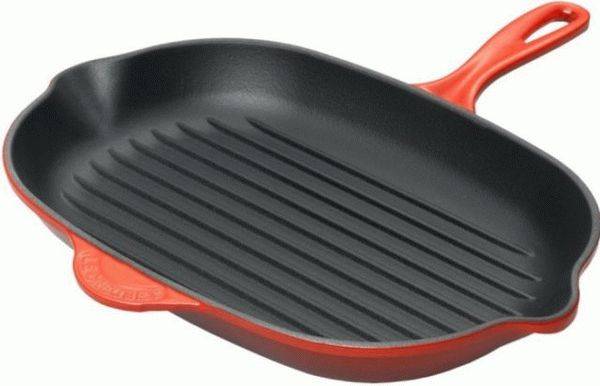
Please note that you cannot pour water on pans with a ceramic coating; read about the features of caring for them in our other article. Most often, sticking and sticking problems begin when the coating is damaged.
You shouldn't wash such a cast iron pan. It is better to get rid of it mercilessly, if the manufacturer has not indicated in the instructions that after the protective layer is damaged, the dishes are harmless. But be prepared that rust may appear in places of abrasion or scratches.
Most often, sticking and sticking problems begin when the coating is damaged. You shouldn't wash such a cast iron pan. It is better to get rid of it mercilessly if the manufacturer did not indicate in the instructions that after the protective layer is damaged, the dishes are harmless. But be prepared that rust can appear in places of abrasion or scratches.
If you wash and store your cast iron skillet properly, it will last for several decades. Many families have cauldrons left over from their great-grandmothers. Is this not evidence of the durability of the material?
Step-by-step instructions for different ways of processing a frying pan
In order to put the pan into operation correctly and in the future to avoid strong odors and food burning, you must follow the instructions exactly.

To avoid damage to the appliance, it is important to ensure that the ignition method is suitable for the coating.
Salt method
This method is great for the following pans:
- cast iron;
- made of stainless steel;
- copper coated with stainless steel.
First, wash the pan thoroughly with soap and wipe. Then a layer of salt of about 3 cm is poured onto the bottom and the device begins to ignite over low heat. The procedure takes about half an hour. The salt will most likely turn yellow as it will soak up residual factory grease. Sometimes housewives ask the question of how to ignite a frying pan with sea salt? The technique is the same.
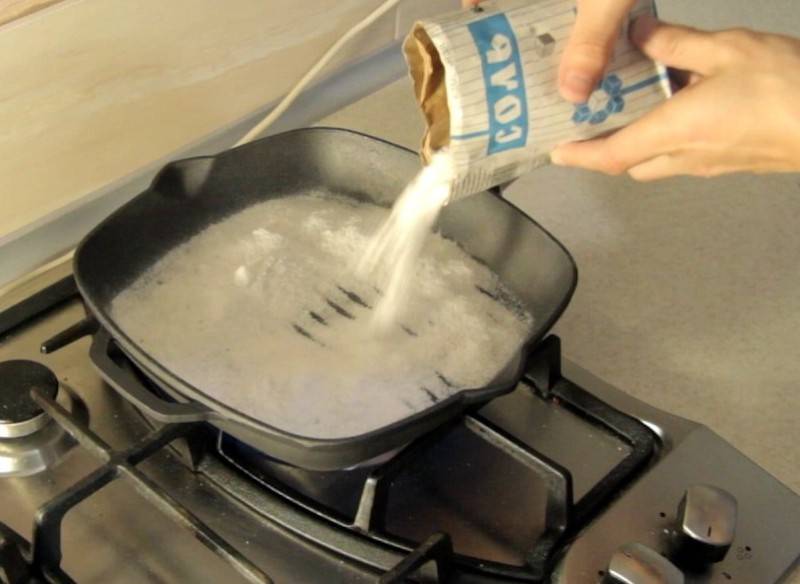
This method is the most common and is distinguished by its simplicity.
We use vegetable oil
Vegetable or animal oil is a great way to create a DIY non-stick finish. This happens because oil, when heated, penetrates into the micropores, and then, when it cools, remains inside the pan. That is, with subsequent heating, the oil will protect the food from contact with microcracks in the coating. But it is best to use oils with a high smoke point:
- coconut;
- sesame;
- olive;
- soy.
Put the cold frying pan on the stove, pour oil on the bottom and start heating. When the oil begins to smoke, remove the appliance from the stove, carefully distribute the oil along the walls and leave to cool. Then wipe off the excess with a cloth.

A common method of preparation for operation using oil.
How to process on the stove
You can also ignite the pan on the stove without using additional products.
- The device must be washed thoroughly.
- Dry with a towel.
- Place on the stove and heat.
- As soon as the pan stops smoking, remove any residual factory grease that has come to the surface and leave the pan to cool.

The easiest way to ignite a pan on the stove is. But it is imperative to observe safety precautions and control the process.
How to light a new frying pan in the oven
If the frying pan has a removable handle or iron handle, it can be baked in the oven.Wash the pan, heat the oven to 200 C, line the lower rack with foil or put a baking sheet. Place the appliance upside down on the upper rack. Heat the pan for 30 minutes, then turn off the oven and leave the pan inside until it cools completely.

The method of preparing the pan for the first use in the oven saves a lot of time, because you do not need to stand near the stove.
How to prepare a new nonstick skillet for use
How to prepare a new non-stick frying pan for use is an important question, because, for example, the Teflon coating does not tolerate high temperatures. But it is still possible to ignite it. It is necessary to heat the pan to 200 C, grease it with oil and cover with a lid and leave it like that until it cools completely. Wipe off any remaining oil with a cloth.

Before using a new frying pan, it is sufficient to rinse it with a sponge without using an abrasive detergent.
Characteristics and properties of cast iron cookware
Cast iron is iron with a high carbon content, added phosphorus and silicon. This allows products made from this material to heat up gradually and evenly along the bottom, walls and lid.
Cast iron cookware is suitable for use on any type of stove, including electric, gas, induction, etc. Pans, pots and other cast iron products are used for cooking in the oven and open fire. This makes the material versatile and practical.
In a cast-iron pan or cauldron, you can easily cook vegetable, meat and fish dishes, soups and cereals, sauces and much more. The food turns out to be healthy, rich, tasty and tender. And shortly before the end of cooking, we can turn off the stove. The dish will come to readiness on its own, because cast iron keeps well and keeps the required temperature. This will help save electricity or gas.
Among the minuses, we note the heavy weight of the material, which complicates the preparation of some dishes, for example, pancakes. Uncoated cast iron is susceptible to corrosion. To prevent the dishes from rusting, it is recommended to periodically warm the products over a fire and immediately wipe the items dry after washing. Coated material will not rust, but may crack.
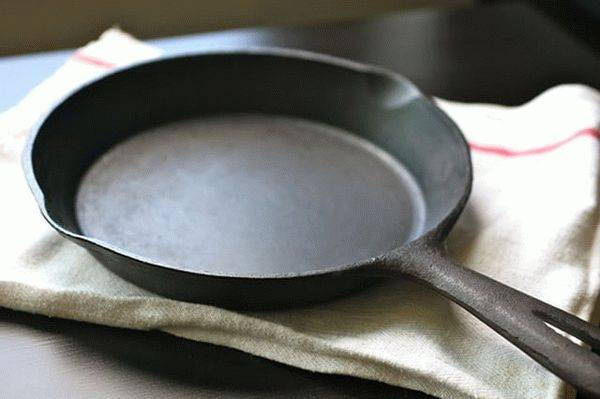
Cast iron absorbs odors well, so it is not recommended to store food in such dishes. In addition, it is recommended to wash the products immediately after preparation, since the cooled material is difficult to wash off. Now let's look at how to properly care for cast iron cookware. And learn what to do before using the cast iron pan for the first time.
Caring for old dirty dishes
If it so happens that old dirt remains on the dishes, they clean the cast iron in different ways. There are a few simple ways to clean your cast iron skillet after cooking, efficiently and without damaging the coating or the material itself. This is especially true for the care of a cast-iron grill pan, because grilling is a long and tedious process, and the dish often sticks and remains on the product.
- A solution of glue, soda and washing powder. All these components must be diluted with water and placed in a frying pan in this container. Then boil for two hours;
A solution of glue, baking soda and washing powder will help you get rid of carbon deposits.
- Acetic acid will help with burned fat. Gently wipe the surface with it and then rinse thoroughly so as not to expose yourself and your family to danger;
Acetic acid will help with burned fat.
- The new assistant in the kitchen of housewives is Coca-Cola. Just leave the pot in a tasty drink overnight and the next morning you will not recognize it - the old dirt will simply disappear.
The old dirt will simply fall off thanks to Coca-Cola.
Do not clean cast iron with strong acids or harsh materials, as this material can be severely damaged.
It is better to immediately clean the contaminated cast iron, so that later you do not resort to extreme measures using acids and hard surfaces.
Why cast iron pans are calcined
In order for your cast-iron frying pan to bring only benefits and cope with its duties, first of all it needs to be ignited. If the product is new, it is fired, getting rid of the engine oil layer. They cover cast-iron dishes at the factory so as not to rust. Old pans are calcined to remove the perennial layer of carbon deposits.
There are three main purposes for calcining:
- Removing a layer of factory oil or carbon deposits from an old pan.
- Creates a non-stick coating on the inner surface.
- Corrosion prevention.
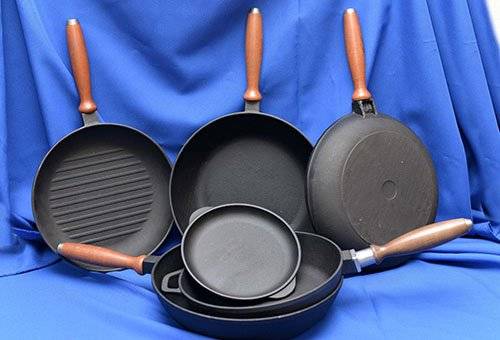
Roasting cast iron pans helps to get rid of machine oil and carbon deposits
When heated, the pores of the material expand, and particles of vegetable oil enter them. As the pan cools, the pores narrow and the oil creates a thin layer that serves as a non-stick coating. It also has an anti-corrosion function, protecting cast iron from rust.
In the process of calcining, they use the means that are always in the kitchen: salt and vegetable oil.
Daily care
Daily care of cast iron cookware will not cause any particular difficulties, and will prevent the formation of carbon deposits. After each use, it is necessary to carefully remove food debris and then rinse off any accumulated grease.
Next, it is very important to rinse the container with hot water, or even better, use boiling water. Wipe the surface with paper towels, and then brush with a small amount of vegetable oil
In order to remove accumulated fat from the inner walls of the pan, you must:
- pour 3 tablespoons of table salt and a little vinegar into the pan;
- pour water over the pan;
- send to the stove and bring the liquid to boiling point;
- add 4 tablespoons of baking soda and do not touch until the liquid in the dish has completely evaporated;
- very thoroughly wash the surfaces of the container with hot water.
The use of cast iron cookware also requires compliance with the following rules:
- after finishing cooking in a pan, it is necessary to remove food debris or fat using a napkin or paper towel;
- do not use dishwashing gel, which can dissolve the non-stick coating of the product, and food will stick to the surface of the dish during cooking;
- do not wash the cast iron pan in the dishwasher;
- do not leave dishes in clean water or soapy water for a long time;
- after washing, it is necessary to wipe the dishes well with a cloth or paper towels, because due to the remaining drops, rust may appear soon;
- the inside of the pan should be greased with a small amount of vegetable oil, the excess of which should be removed with a paper towel - this procedure will preserve the non-stick properties of the dishes and prevent oxidative processes;
- to prevent corrosive processes, it is worth storing the cast iron pan in a dry place.
 The pan must be thoroughly cleaned of food debris.
The pan must be thoroughly cleaned of food debris. Cast iron is brittle and can crack if misused
Cast iron is brittle and can crack if misused


